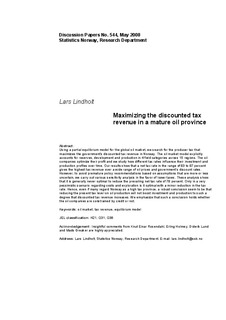Maximizing the discounted tax revenue in a mature oil province
Working paper

Åpne
Permanent lenke
http://hdl.handle.net/11250/180609Utgivelsesdato
2008Metadata
Vis full innførselSamlinger
- Discussion Papers [1002]
Sammendrag
Abstract:
Using a partial equilibrium model for the global oil market, we search for the producer tax that maximizes the government’s discounted tax revenue in Norway. The oil market model explicitly accounts for reserves, development and production in 4 field categories across 15 regions. The oil companies optimize their profit and we study how different tax rates influence their investment and production profiles over time. Our results show that a net tax rate in the range of 83 to 87 percent gives the highest tax revenue over a wide range of oil prices and government’s discount rates. However, to avoid premature policy recommendations based on assumptions that are more or less uncertain, we carry out various sensitivity analysis in the favor of lower taxes. These analysis show that it is generally never optimal to reduce the prevailing net tax rate of 78 percent. Only in a very pessimistic scenario regarding costs and exploration is it optimal with a minor reduction in the tax rate. Hence, even if many regard Norway as a high tax province, a robust conclusion seem to be that reducing the present tax level on oil production will not boost investment and production to such a degree that discounted tax revenue increases. We emphasize that such a conclusion holds whether the oil companies are constrained by credit or not.
Keywords: oil market, tax revenue, equilibrium model
JEL classification: H21, Q31, Q38
Beskrivelse
Authors website: http://www.ssb.no/english/research/people/lli/index.html